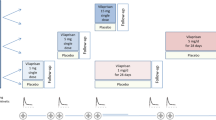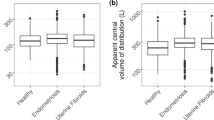Abstract
Pharmacokinetic properties such as absorption, distribution, metabolism, and elimination of drugs often differ between men and women and change over lifetime. Women experience more adverse events and side-effects of medications than men. Hormonal changes during the menstrual cycle usually have limited effect on the pharmacokinetics of drugs, except for drugs that interfere with QT-interval. It is debated whether there is a systematic difference in compliance to medication in women compared to men. Drug interactions and drug safety during pregnancy are discussed.
Access this chapter
Tax calculation will be finalised at checkout
Purchases are for personal use only
Similar content being viewed by others
References
Socialstyrelsen. Statistik om läkemedel år 2015 (Drug Statistics, Swedish Board of Health and Welfare). http://www.socialstyrelsen.se/publikationer2016/2016-4-4. Accessed 31 Jul 2016.
Loikas D, Wettermark B, von Euler M, Bergman U, Schenck-Gustafsson K. Differences in drug utilisation between men and women: a cross-sectional analysis of all dispensed drugs in Sweden. BMJ Open. 2013;3(5):e002378.
Mattison D, Mattison FA. Drug disposition and effect. In: Handbook of clinical gender medicine. Basel: Karger Medical and Scientific Publishers; 2012. p. 473–9.
Koren G. Sex dependent pharmacokinetics and bioequivalence—time for a change. J Popul Ther Clin Pharmacol. 2013;20:e358–61.
Anderson GD. Gender differences in pharmacological response. Int Rev Neurobiol. 2008;83:1–10.
Anderson GD. Sex and racial differences in pharmacological response: where is the evidence? Pharmacogenetics, pharmacokinetics, and pharmacodynamics. J Women’s Health. 2005;14:19–29.
Franconi F, Campesi I. Pharmacogenomics, pharmacokinetics and pharmacodynamics: interaction with biological differences between men and women. Br J Pharmacol. 2014;171:580–94.
Fischer M, Baessler A, Schunkert H. Renin angiotensin system and gender differences in the cardiovascular system. Cardiovasc Res. 2002;53:672–7.
Hutson WR, Roehrkasse RL, Wald A. Influence of gender and menopause on gastric emptying and motility. Gastroenterology. 1989;96:11–7.
Mearadji B, Penning C, Vu MK, van der Schaar PJ, van Petersen AS, Kamerling IM, Masclee AA. Influence of gender on proximal gastric motor and sensory function. Am J Gastroenterol. 2001;96:2066–73.
Sadik R, Abrahamsson H, Stotzer PO. Gender differences in gut transit shown with a newly developed radiological procedure. Scand J Gastroenterol. 2003;38:36–42.
Schwartz JB. The influence of sex on pharmacokinetics. Clin Pharmacokinet. 2003;42:107–21.
Singer AJ, Brandt LJ. Pathophysiology of the gastrointestinal tract during pregnancy. Am J Gastroenterol. 1991;86:1695–712.
Spoletini I, Vitale C, Malorni WMC, Rosano GM. Sex differences in drug effects: interaction with sex hormones in adult life. Sex and gender differences in pharmacology. In: Regitz-Zagrosek W, editor. Handbook of experimental pharmacology, vol. 214. Berlin: Springer; 2012. p. 91–105.
Rodriguez I, Kilborn MJ, Liu XK, Pezzullo JC, Woosley RL. Drug-induced QT prolongation in women during the menstrual cycle. JAMA. 2001;285:1322–6.
Lazarou J, Pomeranz BH, Corey PN. Incidence of adverse drug reactions in hospitalized patients: a meta-analysis of prospective studies. JAMA. 1998;279:1200–5.
von Euler M, Eliasson E, Öhlén G, Bergman U. Adverse drug reactions causing hospitalization can be monitored from computerized medical records and thereby indicate the quality of drug utilization. Pharmacoepidemiol Drug Saf. 2006;15:179–84.
Leise MD, Poterucha JJ, Talwalkar JA. Drug-induced liver injury. Mayo Clin Proc. 2014;89:95–106.
Amacher DE. Female gender as a susceptibility factor for drug-induced liver injury. Hum Exp Toxicol. 2014;33:928–39.
Melloni C, Berger JS, Wang TY, Gunes F, Stebbins A, Pieper KS, Dolor RJ, Douglas PS, Mark DB, Newby LK. Representation of women in randomized clinical trials of cardiovascular disease prevention. Circ Cardiovasc Qual Outcomes. 2010;3:135–42.
Eriksson I, Bergman U, Vlahovic-Palcevski V, von Euler M. Drug utilization studies across patient and prescriber characteristics. In: Elseviers M, Wettermark B, Birna Almarsdóttir A, Andersen M, Benko R, Bennie M, Eriksson I, Godman B, Krska J, Poluzzi E, Taxis K, Vlahovic-Palcevski V, Vander Stichele R, editors. Drug utilization research: methods and applications. Hoboken: Wiley; 2016.
Stephen M, Wiggins HS, Englyst HN. The effect of age, sex and level of intake of dietary fibre from wheat on large-bowel function in thirty healthy subjects. Br J Nutr. 1986;56:349–61.
Goodman DE, Israel E, Rosenberg M, Johnston R, Weiss ST, Drazen JM. The influence of age, diagnosis, and gender on proper use of metered-dose inhalers. Am J Respir Crit Care Med. 1994;150:1256–61.
Atkinson AJ, Anernathy DR, Daniels CE, Dedrick RL, Markey SP, editors. Principles of clinical pharmacology. 2nd ed. San Diego: Academic/Elsevier; 2007.
Frezza M, di Padova C, Pozzato G, Terpin M, Baraona E, Lieber CS. High blood alcohol levels in women. The role of decreased gastric alcohol dehydrogenase activity and first-pass metabolism. N Engl J Med. 1990;322:95–9.
SBU. Skattning av njurfunktion: en systematisk litteraturöversikt. Rapport nr: 214. Mölnlycke: Elanders; 2013. ISBN: 978-91-85413-53-9.
Skoglund P. Farmakokinetiska grundbegrepp. Apoteket AB. Marknads-/Försäljningsstöd; 2001.
Pieper PG. Use of medication for cardiovascular disease during pregnancy. Nat Rev Cardiol. 2015;12:718–29.
Mitoff PR, Gam D, Ivanov J, Al-hesayen A, Azevedo ER, Newton GE, Parker JD, Mak S. Cardiac-specific sympathetic activation in men and women with and without heart failure. Heart. 2011;97:382–7.
Momen A, Gao Z, Cohen A, Khan T, Leuenberger UA, Sinoway LI. Coronary vasoconstrictor responses are attenuated in young women as compared with age-matched men. J Physiol. 2010;588:4007–16.
Kneale BJ, Chowienczyk PJ, Brett SE, Coltart DJ, Ritter JM. Gender differences in sensitivity to adrenergic agonists of forearm resistance vasculature. J Am Coll Cardiol. 2000;36:1233.
Wheeldon NM, Newnham DM, Coutie WJ, Peters JA, McDevitt DG, Lipworth BJ. Influence of sex-steroid hormones on the regulation of lymphocyte beta 2-adrenoceptors during the menstrual cycle. Br J Clin Pharmacol. 1994;37:583–8.
Kam KW, Qi JS, Chen M, Wong TM. Estrogen reduces cardiac injury and expression of beta1-adrenoceptor upon ischemic insult in the rat heart. J Pharmacol Exp Ther. 2004;309:8–15.
Thawornkaiwong A, Preawnim S, Wattanapermpool J. Upregulation of β1-adrenergic receptors in ovariectomized rat hearts. Life Sci. 2003;72:1813–24.
Kotecha D, Manzano L, Krum H, et al. Effect of age and sex on efficacy and tolerability of β-blockers in patients with heart failure with reduced ejection fraction: individual patient data meta-analysis. BMJ. 2016;353:i18.
Weinberger AH, McKee SA, Mazure CM. Inclusion of women and gender-specific analyses in randomized clinical trials of treatments for depression. J Womens Health (Larchmt). 2010;19:1727–32.
Tannenbaum C, Schwarz JM, Clayton JA, de Vries GJ, Sullivan C. Evaluating sex as a biological variable in preclinical research: the devil in the details. Biol Sex Differ. 2016;7:13. doi:10.1186/s13293-016-0066-x.
Ward KE, Archambault R, Mersfelder TL. Severe adverse skin reactions to nonsteroidal anti-inflammatory drugs: a review of the literature. Am J Health Syst Pharm. 2010;67:206–13.
Willis CM, Shaw S, De Lacharrière O, Baverel M, Reiche L, Jourdain R, Bastien P, Wilkinson JD. Sensitive skin: an epidemiological study. Br J Dermatol. 2001;145:258–63.
Moss AJ. The QT interval and Torsade de pointes. Drug Saf. 1999;21(Suppl. 1):5–10.
Taylor CJ, Hodgkinson J, Hobbs FD. Rhythm control agents and adverse events in patients with atrial fibrillation. Int J Clin Pract. 2010;64:1069–75.
Roden DM. Drug-induced prolongation of the QT interval. N Engl J Med. 2004;350:1013–22.
Makkar RR, Fromm BS, Steinman RT, Meissner MD, Lehmann MH. Female gender as a risk factor for Torsades de pointes associated with cardiovascular drugs. JAMA. 1993;270:2590–7.
Fitzgerald PT, Ackerman MJ. Drug-induced torsades de pointes: the evolving role of pharmacogenetics. Heart Rhythm. 2005;2:S30–7.
Lehmann MH, Hardy S, Archibald D, MacNeil DJ. QTc prolongation with d,l-sotalol in women versus men. Am J Cardiol. 1999;83:354–9.
Schenck-Gustafsson K, Dahlqvist R. Pharmacokinetics of digoxin in patients subjected to the quinidine-digoxin interaction. Br J Clin Pharmacol. 1981;11(2):181–6.
Reinoehl J, Frankovich D, Machado C, Kawasaki R, Baga JJ, Pires LA, et al. Probucol associated tachyarrhythmic events and QT prolongation: importance of gender. Am Heart J. 1996;131:1184–91.
Lim HE, Pak HN, Ahn JC, Song WH, Kim YH. Torsade de pointes induced by short-term oral amiodarone therapy. Europace. 2006;8:1051–3.
Os I, Bratland B, Dahlof B, Gisholt K, Syvertsen JO, Tretli S. Female sex as an important determinant of lisinopril-induced cough. Lancet. 1992;339:372.
Pasternak RC, Smith Jr SC, Bairey-Merz CN, Grundy SM, Cleeman JI, Lenfant C. ACC/AHA/NHLBI clinical advisory on the use and safety of statins. Circulation. 2002;106:1024–8.
Hou Q, Li S, Li L, Li Y, Sun X, Tian H. Association between SLCO1B1 gene T521C, polymorphism and statin-related myopathy risk: a meta-analysis of case-control studies. Medicine (Baltimore). 2015;94(37):e1268.
Luzum JA, Kitzmiller JP, Isackson PJ, Ma C, Medina MW, Dauki AM, et al. GATM polymorphism associated with the risk for statin-induced myopathy does not replicate in case-control analysis of 715 dyslipidemic individuals. Cell Metab. 2015;21:622–7.
Rosano GM, Lewis B, Agewall S, Wassmann S, Vitale C, Schmidt H, et al. Gender differences in the effect of cardiovascular drugs: a position document of the working group on pharmacology and drug therapy of the ESC. Eur Heart J. 2015;36:2677–80.
Kardas P, Lewek P, Matyjaszczyk M. Determinants of patient adherence: a review of systematic reviews. Front Pharmacol. 2013;4:1–16.
DiMatteo MR. Variations in patients’ adherence to medical recommendations: a quantitative review of 50 years of research. Med Care. 2004;42:200–9.
Regitz-Zagrosek V, Blomstrom Lundqvist C, Borghi C, Cifkova R, Ferreira R, Foidart J-M, Gibbs JSR, Gohlke-Baerwolf C, Gorenek B, Iung B, Kirby MC, Maas AHEM, Morais J, Nihoyannopoulos P, Pieper PG, Presbitero P, Roos-Hesselink JW, Schaufelberger M, Seeland U, Torracca L. ESC guidelines on the management of cardiovascular diseases during pregnancy. Eur Heart J. 2011;32:3147–97.
Lupattelli A, Spigset O, Björnsdóttir I, Hämeen-Anttila K, Mårdby AC, Panchaud A, Juraski RG, Rudolf G, Odalovic M, Drozd M, Twigg MJ, Juch H, Moretti ME, Kennedy D, Rieutord A, Zagorodnikova K, Passier A, Nordeng H. Patterns and factors associated with low adherence to psychotropic medications during pregnancy—a cross-sectional, multinational web-based study. Depress Anxiety. 2015;32:426–36.
Author information
Authors and Affiliations
Corresponding author
Editor information
Editors and Affiliations
Rights and permissions
Copyright information
© 2017 Springer International Publishing AG
About this chapter
Cite this chapter
Schenck-Gustafsson, K., von Euler, M. (2017). Pharmacotherapy in Women. In: Maas, A., Bairey Merz, C. (eds) Manual of Gynecardiology. Springer, Cham. https://doi.org/10.1007/978-3-319-54960-6_14
Download citation
DOI: https://doi.org/10.1007/978-3-319-54960-6_14
Published:
Publisher Name: Springer, Cham
Print ISBN: 978-3-319-54959-0
Online ISBN: 978-3-319-54960-6
eBook Packages: MedicineMedicine (R0)




